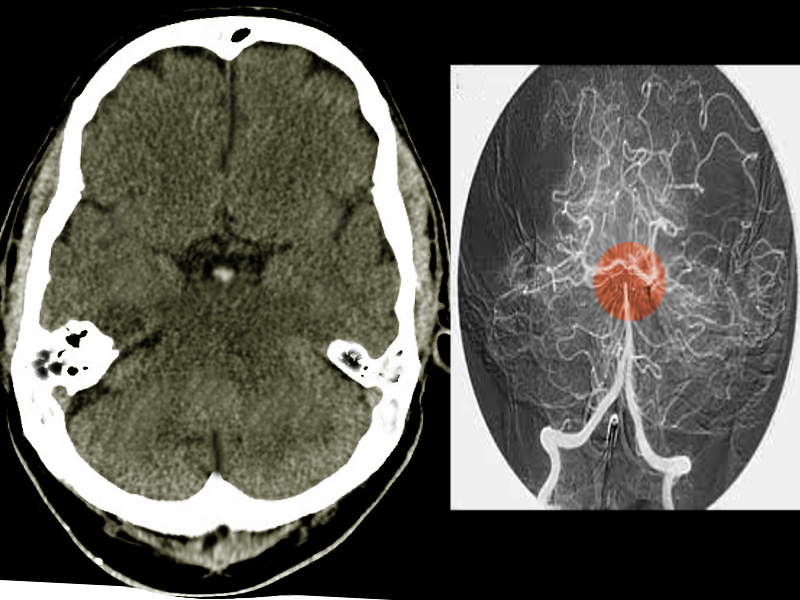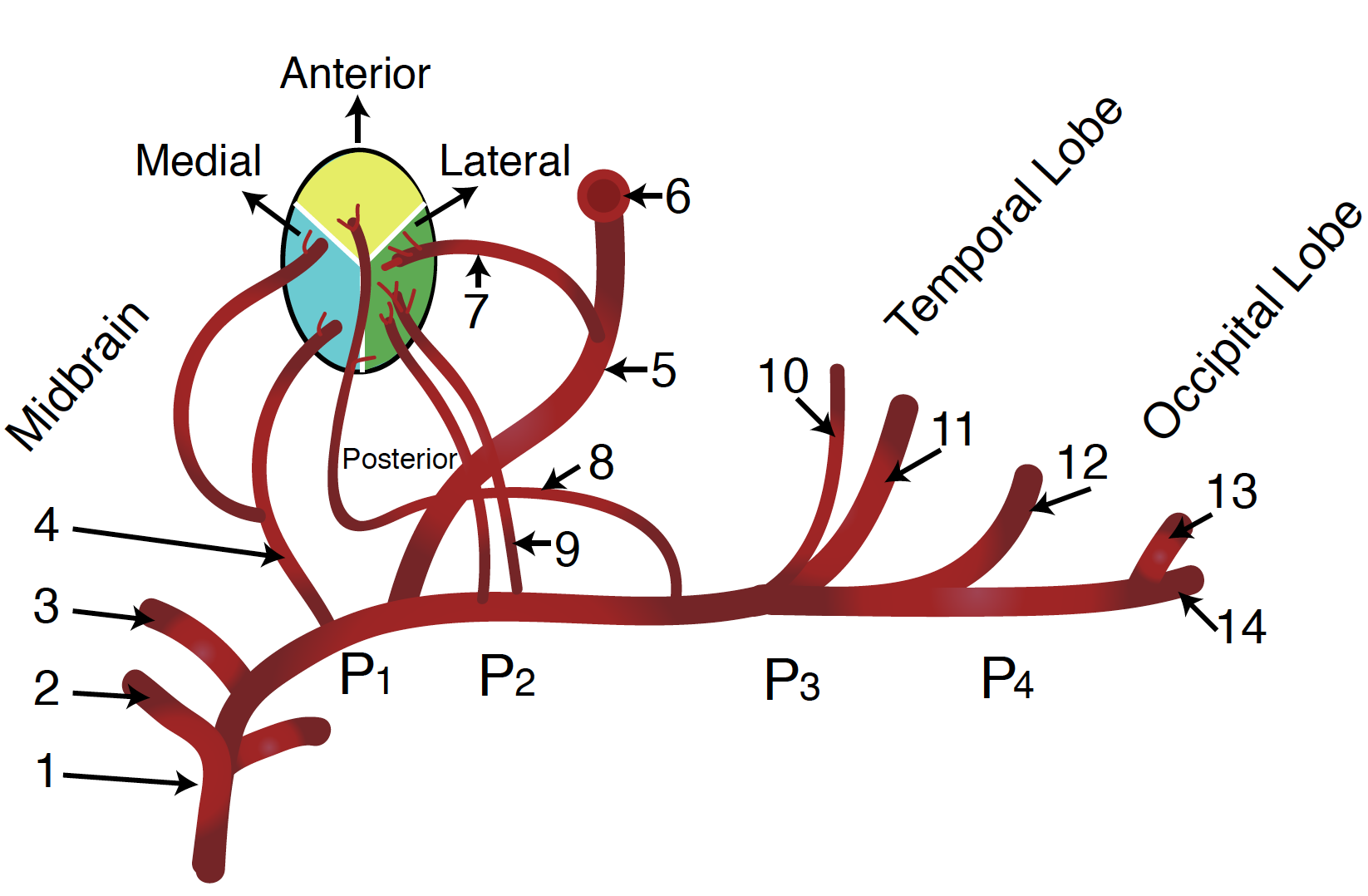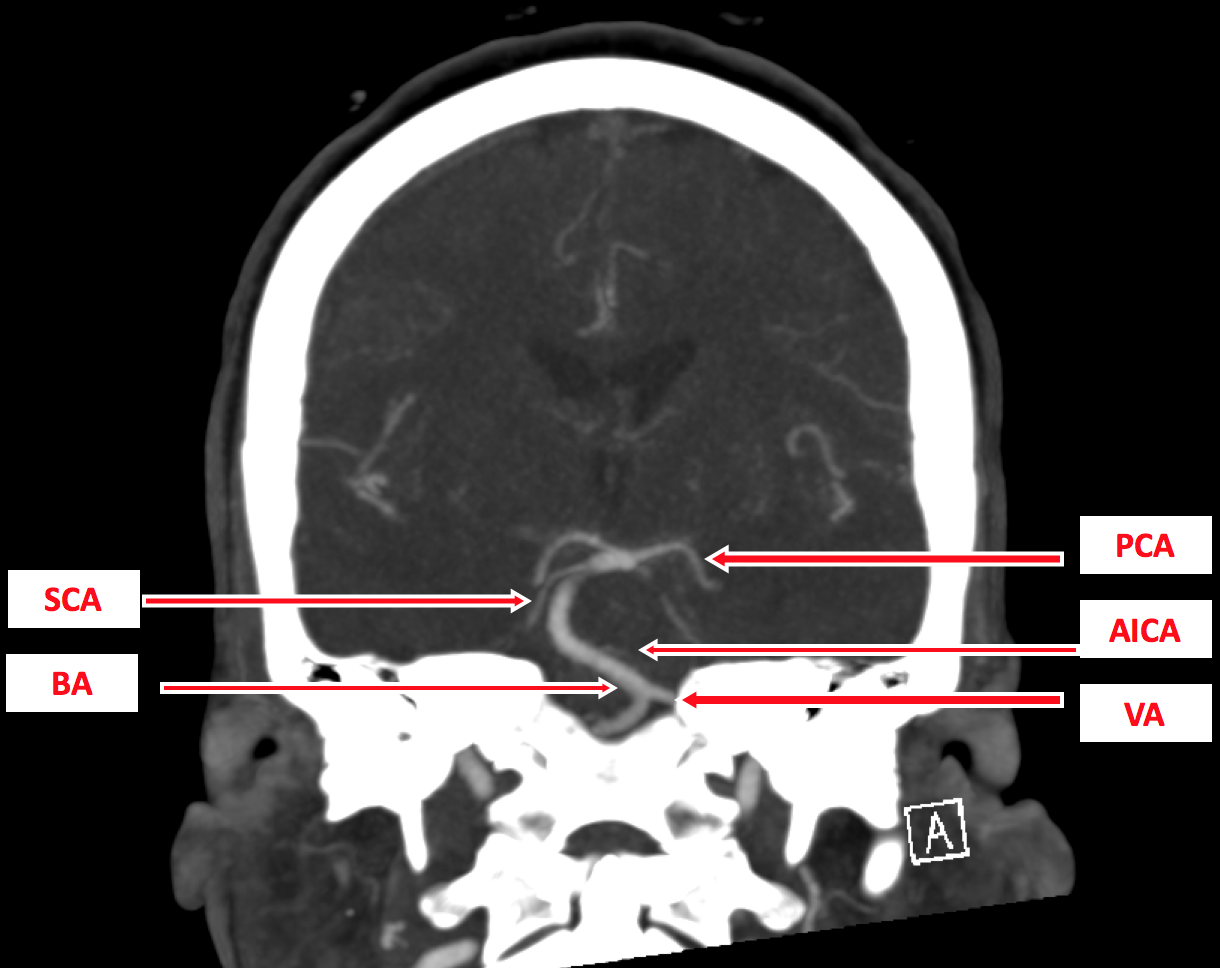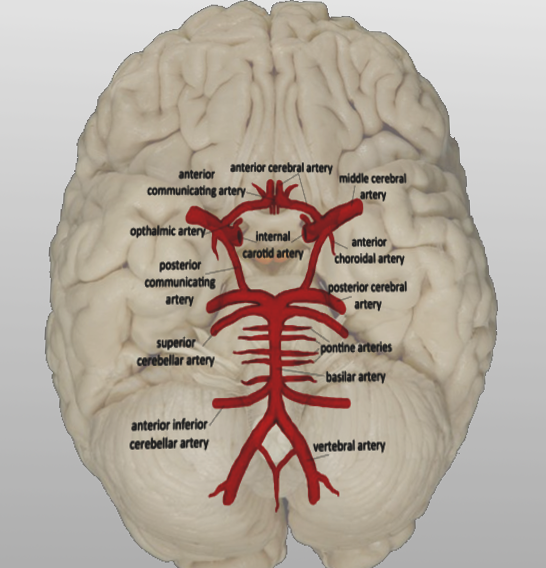[1]
Mattle HP, Arnold M, Lindsberg PJ, Schonewille WJ, Schroth G. Basilar artery occlusion. The Lancet. Neurology. 2011 Nov:10(11):1002-14. doi: 10.1016/S1474-4422(11)70229-0. Epub
[PubMed PMID: 22014435]
[2]
Kompanje EJ, Walgaard C, de Groot YJ, Stevens M. Historical sources of basilar artery occlusion. Neurology. 2011 Apr 26:76(17):1520-3. doi: 10.1212/WNL.0b013e318217e755. Epub
[PubMed PMID: 21519003]
[3]
Voetsch B, DeWitt LD, Pessin MS, Caplan LR. Basilar artery occlusive disease in the New England Medical Center Posterior Circulation Registry. Archives of neurology. 2004 Apr:61(4):496-504
[PubMed PMID: 15096396]
[4]
Albers GW, Marks MP, Kemp S, Christensen S, Tsai JP, Ortega-Gutierrez S, McTaggart RA, Torbey MT, Kim-Tenser M, Leslie-Mazwi T, Sarraj A, Kasner SE, Ansari SA, Yeatts SD, Hamilton S, Mlynash M, Heit JJ, Zaharchuk G, Kim S, Carrozzella J, Palesch YY, Demchuk AM, Bammer R, Lavori PW, Broderick JP, Lansberg MG, DEFUSE 3 Investigators. Thrombectomy for Stroke at 6 to 16 Hours with Selection by Perfusion Imaging. The New England journal of medicine. 2018 Feb 22:378(8):708-718. doi: 10.1056/NEJMoa1713973. Epub 2018 Jan 24
[PubMed PMID: 29364767]
[5]
Nogueira RG, Jadhav AP, Haussen DC, Bonafe A, Budzik RF, Bhuva P, Yavagal DR, Ribo M, Cognard C, Hanel RA, Sila CA, Hassan AE, Millan M, Levy EI, Mitchell P, Chen M, English JD, Shah QA, Silver FL, Pereira VM, Mehta BP, Baxter BW, Abraham MG, Cardona P, Veznedaroglu E, Hellinger FR, Feng L, Kirmani JF, Lopes DK, Jankowitz BT, Frankel MR, Costalat V, Vora NA, Yoo AJ, Malik AM, Furlan AJ, Rubiera M, Aghaebrahim A, Olivot JM, Tekle WG, Shields R, Graves T, Lewis RJ, Smith WS, Liebeskind DS, Saver JL, Jovin TG, DAWN Trial Investigators. Thrombectomy 6 to 24 Hours after Stroke with a Mismatch between Deficit and Infarct. The New England journal of medicine. 2018 Jan 4:378(1):11-21. doi: 10.1056/NEJMoa1706442. Epub 2017 Nov 11
[PubMed PMID: 29129157]
[6]
Campbell BC, Mitchell PJ, Churilov L, Yassi N, Kleinig TJ, Yan B, Thijs V, Desmond PM, Parsons MW, Donnan GA, Davis SM. Determining the optimal dose of tenecteplase before endovascular therapy for ischemic stroke (EXTEND-IA TNK Part 2): A multicenter, randomized, controlled study. International journal of stroke : official journal of the International Stroke Society. 2020 Jul:15(5):567-572. doi: 10.1177/1747493019879652. Epub 2019 Sep 30
[PubMed PMID: 31564231]
Level 1 (high-level) evidence
[7]
Ravindren J, Aguilar Pérez M, Hellstern V, Bhogal P, Bäzner H, Henkes H. Predictors of Outcome After Endovascular Thrombectomy in Acute Basilar Artery Occlusion and the 6hr Time Window to Recanalization. Frontiers in neurology. 2019:10():923. doi: 10.3389/fneur.2019.00923. Epub 2019 Sep 25
[PubMed PMID: 31608001]
[8]
Ikram A,Farooqui M,Suriya S,Quadri SA,Zafar A, Smog Sign: Hazy Diffusion-weighted Imaging Restriction in Dense Axonal Tracts in the Pons on Hyperacute MRI with Remarkable Clinical Improvement After Intra-arterial Thrombectomy. Cureus. 2019 Aug 22;
[PubMed PMID: 31641558]
[9]
Savitz SI, Caplan LR. Vertebrobasilar disease. The New England journal of medicine. 2005 Jun 23:352(25):2618-26
[PubMed PMID: 15972868]
[10]
Berti AF, Zafar A, Ikram A, Calder CS, Sorte DE. Recurrent posterior circulation infarcts secondary to vertebral artery external compression treated with endovascular deconstruction. Interventional neuroradiology : journal of peritherapeutic neuroradiology, surgical procedures and related neurosciences. 2018 Apr:24(2):178-182. doi: 10.1177/1591019917747879. Epub 2017 Dec 14
[PubMed PMID: 29239686]
[11]
Gómez-Martí M, Boschín V, Puchades F, Cerdán A, Cunquero A, Sanz F, Tamarit JJ. [Ischaemic stroke due to basilar artery occlusion in a puerperal patient with SARS-CoV-2 infection]. Revista de neurologia. 2022 Aug 16:75(4):97-100. doi: 10.33588/rn.7504.2021373. Epub
[PubMed PMID: 35866535]
[12]
Tsuchiya T,Koizumi S,Tomioka A,Miyawaki S,Saito N, Acute Ischemic Stroke Due to Basilar Artery Occlusion with Coronavirus Disease 2019: A Case Report. NMC case report journal. 2021
[PubMed PMID: 35079520]
Level 3 (low-level) evidence
[13]
Zhang W, Xing W, Gu H, He J. Acute pontine infarction in a patient with 8-shaped basilar artery fenestration malformation: A case report. Medicine. 2022 Jul 8:101(27):e29445. doi: 10.1097/MD.0000000000029445. Epub 2022 Jul 8
[PubMed PMID: 35801744]
Level 3 (low-level) evidence
[14]
Aoki T, Kuwayama K, Kobata H, Ito A, Fuji K, Sakamoto M, Furuno Y, Matsumoto K. Endovascular Mechanical Thrombectomy for Basilar Artery Occlusion Caused by Thrombosis as an Initial Manifestation of Acute Myelogenous Leukemia: A Case Report. NMC case report journal. 2021:8(1):767-772. doi: 10.2176/nmccrj.cr.2021-0212. Epub 2021 Nov 2
[PubMed PMID: 35079546]
Level 3 (low-level) evidence
[15]
Deshpande GG, Riffle RM, Meagher S. Basilar artery stroke in Crohn's disease treated with endovascular thromboembolectomy. BMJ case reports. 2022 Apr 11:15(4):. doi: 10.1136/bcr-2021-244652. Epub 2022 Apr 11
[PubMed PMID: 35410945]
Level 3 (low-level) evidence
[16]
Israeli-korn SD,Schwammenthal Y,Yonash-Kimchi T,Bakon M,Tsabari R,Orion D,Bruk B,Molshatzki N,Merzeliak O,Chapman J,Tanne D, Ischemic stroke due to acute basilar artery occlusion: proportion and outcomes. The Israel Medical Association journal : IMAJ. 2010 Nov;
[PubMed PMID: 21243866]
[17]
Rai AT, Seldon AE, Boo S, Link PS, Domico JR, Tarabishy AR, Lucke-Wold N, Carpenter JS. A population-based incidence of acute large vessel occlusions and thrombectomy eligible patients indicates significant potential for growth of endovascular stroke therapy in the USA. Journal of neurointerventional surgery. 2017 Aug:9(8):722-726. doi: 10.1136/neurintsurg-2016-012515. Epub 2016 Jul 15
[PubMed PMID: 27422968]
[18]
Schonewille WJ, Wijman CA, Michel P, Rueckert CM, Weimar C, Mattle HP, Engelter ST, Tanne D, Muir KW, Molina CA, Thijs V, Audebert H, Pfefferkorn T, Szabo K, Lindsberg PJ, de Freitas G, Kappelle LJ, Algra A, BASICS study group. Treatment and outcomes of acute basilar artery occlusion in the Basilar Artery International Cooperation Study (BASICS): a prospective registry study. The Lancet. Neurology. 2009 Aug:8(8):724-30. doi: 10.1016/S1474-4422(09)70173-5. Epub 2009 Jul 3
[PubMed PMID: 19577962]
[19]
Ferbert A, Brückmann H, Drummen R. Clinical features of proven basilar artery occlusion. Stroke. 1990 Aug:21(8):1135-42
[PubMed PMID: 2389292]
[20]
Conte WL,Gill CE,Biller J, Top of the Basilar Syndrome Presenting With Convulsions. JAMA neurology. 2017 Feb 1
[PubMed PMID: 27992635]
[21]
Wang TL, Wu G, Liu SZ. Convulsive-like movements as the first symptom of basilar artery occlusive brainstem infarction: A case report. World journal of clinical cases. 2022 May 16:10(14):4569-4573. doi: 10.12998/wjcc.v10.i14.4569. Epub
[PubMed PMID: 35663090]
Level 3 (low-level) evidence
[22]
Inui R, Fujiwara S, Kuroda T, Ohara N, Imamura H, Kohara N, Ariyoshi K, Kawamoto M, Sakai N. Convulsive-like symptoms as initial indications of basilar artery occlusion: A case series study. eNeurologicalSci. 2022 Sep:28():100410. doi: 10.1016/j.ensci.2022.100410. Epub 2022 Jun 16
[PubMed PMID: 35757457]
Level 2 (mid-level) evidence
[23]
Aladdin Y, Shirah B, Khan K. Vertical One-and-a-Half Syndrome with Pseudoabducens Palsy and Midbrain Horizontal Gaze Paresis. Journal of binocular vision and ocular motility. 2022 Jul-Sep:72(3):156-160
[PubMed PMID: 35616639]
[24]
Meinel TR,Kaesmacher J,Chaloulos-Iakovidis P,Panos L,Mordasini P,Mosimann PJ,Michel P,Hajdu S,Ribo M,Requena M,Maegerlein C,Friedrich B,Costalat V,Benali A,Pierot L,Gawlitza M,Schaafsma J,Pereira VM,Gralla J,Fischer U, Mechanical thrombectomy for basilar artery occlusion: efficacy, outcomes, and futile recanalization in comparison with the anterior circulation. Journal of neurointerventional surgery. 2019 Jun 25;
[PubMed PMID: 31239331]
[25]
Li Y, Chen F, Yang B, Xie S, Wang C, Guo R, Zhang X, Liu Z. Effect of Mid-Basilar Artery Angle and Plaque Characteristics on Pontine Infarction in Patients with Basilar Artery Plaque. Journal of atherosclerosis and thrombosis. 2023 Feb 1:30(2):182-191. doi: 10.5551/jat.63520. Epub 2022 Apr 13
[PubMed PMID: 35418542]
[26]
Yan S, Zhou Y, Zhao Y, Wang F, Tao A, Zhou L, Pan M, Zhong G, Hu L, Jiang X, Mao X, Tang H, Wang J, Qian S, Sun J, Gong X, Zhong W, Lou M, CASE II investigators. Effect of Imaging Markers on Reperfusion Therapy in Basilar Artery Occlusion. Annals of neurology. 2022 Jul:92(1):97-106. doi: 10.1002/ana.26376. Epub 2022 May 4
[PubMed PMID: 35438200]
Level 2 (mid-level) evidence
[27]
Chen L, Zhao C, Song J, Zi W, Sang H, Yuan J, Huang J, Li L, Luo W, Fu X, Zhou P, Wan Y, Zeng G, Xie D, Gao F, Li F, Qiu Z, Yang Q. Extended Thrombolysis In Cerebral Infarction (eTICI) grade 2c: a potential angiographic target for endovascular treatment in acute basilar artery occlusion? Journal of neurointerventional surgery. 2022 Oct:14(10):1022-1026. doi: 10.1136/neurintsurg-2021-018026. Epub 2021 Nov 15
[PubMed PMID: 34782398]
Level 2 (mid-level) evidence
[28]
Powers WJ,Rabinstein AA,Ackerson T,Adeoye OM,Bambakidis NC,Becker K,Biller J,Brown M,Demaerschalk BM,Hoh B,Jauch EC,Kidwell CS,Leslie-Mazwi TM,Ovbiagele B,Scott PA,Sheth KN,Southerland AM,Summers DV,Tirschwell DL, 2018 Guidelines for the Early Management of Patients With Acute Ischemic Stroke: A Guideline for Healthcare Professionals From the American Heart Association/American Stroke Association. Stroke. 2018 Mar;
[PubMed PMID: 29367334]
[29]
Stroke Unit Trialists' Collaboration. Organised inpatient (stroke unit) care for stroke. The Cochrane database of systematic reviews. 2013 Sep 11:2013(9):CD000197. doi: 10.1002/14651858.CD000197.pub3. Epub 2013 Sep 11
[PubMed PMID: 24026639]
Level 1 (high-level) evidence
[30]
Zhao C, Hu T, Kong W, Yang D, Wan J, Lv K, Liao J, Chen Z, Jiang H, Wu D, Yang P, Zi W, Li F, Yang Q. First-pass effect in patients with acute basilar artery occlusions undergoing stent retriever thrombectomy. Journal of neurosurgery. 2023 Mar 1:138(3):693-700. doi: 10.3171/2022.5.JNS22751. Epub 2022 Jul 8
[PubMed PMID: 35901699]
[31]
Xenos D, Texakalidis P, Karras CL, Murthy NK, Kontzialis M, Rivet DJ, Reavey-Cantwell J. First-Line Stent Retriever versus Direct Aspiration for Acute Basilar Artery Occlusions: A Systematic Review and Meta-analysis. World neurosurgery. 2022 Feb:158():258-267.e1. doi: 10.1016/j.wneu.2021.11.013. Epub 2021 Nov 11
[PubMed PMID: 34775090]
Level 1 (high-level) evidence
[32]
de Havenon A,Elhorany M,Boulouis G,Naggara O,Darcourt J,Clarençon F,Richard S,Marnat G,Bourcier R,Sibon I,Arquizan C,Dargazanli C,Maïer B,Seners P,Lapergue B,Consoli A,Eugene F,Vannier S,Caroff J,Denier C,Boulanger M,Gauberti M,Rouchaud A,Macian F,Rosso C,Turc G,Ozkul-Wermester O,Papagiannaki C,Albucher JF,Le Bras A,Evain S,Wolff V,Pop R,Timsit S,Gentric JC,Bourdain F,Veunac L,Fahed R,Finitsis SN,Gory B,ETIS Registry Investigators., Thrombectomy in basilar artery occlusions: impact of number of passes and futile reperfusion. Journal of neurointerventional surgery. 2022 Apr 21
[PubMed PMID: 35450929]
[33]
ASCEND Study Collaborative Group, Bowman L, Mafham M, Wallendszus K, Stevens W, Buck G, Barton J, Murphy K, Aung T, Haynes R, Cox J, Murawska A, Young A, Lay M, Chen F, Sammons E, Waters E, Adler A, Bodansky J, Farmer A, McPherson R, Neil A, Simpson D, Peto R, Baigent C, Collins R, Parish S, Armitage J. Effects of Aspirin for Primary Prevention in Persons with Diabetes Mellitus. The New England journal of medicine. 2018 Oct 18:379(16):1529-1539. doi: 10.1056/NEJMoa1804988. Epub 2018 Aug 26
[PubMed PMID: 30146931]
[34]
Wang Y, Wang Y, Zhao X, Liu L, Wang D, Wang C, Wang C, Li H, Meng X, Cui L, Jia J, Dong Q, Xu A, Zeng J, Li Y, Wang Z, Xia H, Johnston SC, CHANCE Investigators. Clopidogrel with aspirin in acute minor stroke or transient ischemic attack. The New England journal of medicine. 2013 Jul 4:369(1):11-9. doi: 10.1056/NEJMoa1215340. Epub 2013 Jun 26
[PubMed PMID: 23803136]
[35]
Derdeyn CP, Chimowitz MI, Lynn MJ, Fiorella D, Turan TN, Janis LS, Montgomery J, Nizam A, Lane BF, Lutsep HL, Barnwell SL, Waters MF, Hoh BL, Hourihane JM, Levy EI, Alexandrov AV, Harrigan MR, Chiu D, Klucznik RP, Clark JM, McDougall CG, Johnson MD, Pride GL Jr, Lynch JR, Zaidat OO, Rumboldt Z, Cloft HJ, Stenting and Aggressive Medical Management for Preventing Recurrent Stroke in Intracranial Stenosis Trial Investigators. Aggressive medical treatment with or without stenting in high-risk patients with intracranial artery stenosis (SAMMPRIS): the final results of a randomised trial. Lancet (London, England). 2014 Jan 25:383(9914):333-41. doi: 10.1016/S0140-6736(13)62038-3. Epub 2013 Oct 26
[PubMed PMID: 24168957]
Level 1 (high-level) evidence
[36]
Kernan WN,Ovbiagele B,Black HR,Bravata DM,Chimowitz MI,Ezekowitz MD,Fang MC,Fisher M,Furie KL,Heck DV,Johnston SC,Kasner SE,Kittner SJ,Mitchell PH,Rich MW,Richardson D,Schwamm LH,Wilson JA, Guidelines for the prevention of stroke in patients with stroke and transient ischemic attack: a guideline for healthcare professionals from the American Heart Association/American Stroke Association. Stroke. 2014 Jul;
[PubMed PMID: 24788967]
[37]
Zafar A, Quadri SA, Farooqui M, Ikram A, Robinson M, Hart BL, Mabray MC, Vigil C, Tang AT, Kahn ML, Yonas H, Lawton MT, Kim H, Morrison L. Familial Cerebral Cavernous Malformations. Stroke. 2019 May:50(5):1294-1301. doi: 10.1161/STROKEAHA.118.022314. Epub
[PubMed PMID: 30909834]
[38]
Zulfiqar M, Qeadan F, Ikram A, Farooqui M, Richardson SP, Calder CS, Quadri SA, Mathur P, Ford C, O Gutierrez S, Liera E, Snow H, N Gonzalez J, Zafar A. Intracerebral Hemorrhage in Multiple Sclerosis: A Retrospective Cohort Study. Journal of stroke and cerebrovascular diseases : the official journal of National Stroke Association. 2019 Feb:28(2):267-275. doi: 10.1016/j.jstrokecerebrovasdis.2018.09.050. Epub 2018 Oct 29
[PubMed PMID: 30385221]
Level 2 (mid-level) evidence
[39]
. Low molecular weight heparinoid, ORG 10172 (danaparoid), and outcome after acute ischemic stroke: a randomized controlled trial. The Publications Committee for the Trial of ORG 10172 in Acute Stroke Treatment (TOAST) Investigators. JAMA. 1998 Apr 22-29:279(16):1265-72
[PubMed PMID: 9565006]
Level 1 (high-level) evidence
[40]
Tissue plasminogen activator for acute ischemic stroke. The New England journal of medicine. 1995 Dec 14;
[PubMed PMID: 7477192]
[41]
Yu W, Higashida RT. Endovascular Thrombectomy for Acute Basilar Artery Occlusion: Latest Findings and Critical Thinking on Future Study Design. Translational stroke research. 2022 Dec:13(6):913-922. doi: 10.1007/s12975-022-01008-5. Epub 2022 Mar 29
[PubMed PMID: 35349051]
[42]
Li C, Wu C, Wu L, Zhao W, Chen J, Ren M, Yao C, Yan X, Dong C, Song H, Ma Q, Duan J, Zhang Y, Zhang H, Jiao L, Wang Y, Jovin TG, Ji X, BAOCHE Investigators. Basilar Artery Occlusion Chinese Endovascular Trial: Protocol for a prospective randomized controlled study. International journal of stroke : official journal of the International Stroke Society. 2022 Jul:17(6):694-697. doi: 10.1177/17474930211040923. Epub 2021 Aug 28
[PubMed PMID: 34427475]
Level 1 (high-level) evidence
[43]
Brott TG, Howard G, Roubin GS, Meschia JF, Mackey A, Brooks W, Moore WS, Hill MD, Mantese VA, Clark WM, Timaran CH, Heck D, Leimgruber PP, Sheffet AJ, Howard VJ, Chaturvedi S, Lal BK, Voeks JH, Hobson RW 2nd, CREST Investigators. Long-Term Results of Stenting versus Endarterectomy for Carotid-Artery Stenosis. The New England journal of medicine. 2016 Mar 17:374(11):1021-31. doi: 10.1056/NEJMoa1505215. Epub 2016 Feb 18
[PubMed PMID: 26890472]
[44]
Johnston SC, Easton JD, Farrant M, Barsan W, Conwit RA, Elm JJ, Kim AS, Lindblad AS, Palesch YY, Clinical Research Collaboration, Neurological Emergencies Treatment Trials Network, and the POINT Investigators. Clopidogrel and Aspirin in Acute Ischemic Stroke and High-Risk TIA. The New England journal of medicine. 2018 Jul 19:379(3):215-225. doi: 10.1056/NEJMoa1800410. Epub 2018 May 16
[PubMed PMID: 29766750]
[45]
Pan Y, Elm JJ, Li H, Easton JD, Wang Y, Farrant M, Meng X, Kim AS, Zhao X, Meurer WJ, Liu L, Dietrich D, Wang Y, Johnston SC. Outcomes Associated With Clopidogrel-Aspirin Use in Minor Stroke or Transient Ischemic Attack: A Pooled Analysis of Clopidogrel in High-Risk Patients With Acute Non-Disabling Cerebrovascular Events (CHANCE) and Platelet-Oriented Inhibition in New TIA and Minor Ischemic Stroke (POINT) Trials. JAMA neurology. 2019 Dec 1:76(12):1466-1473. doi: 10.1001/jamaneurol.2019.2531. Epub
[PubMed PMID: 31424481]
[46]
Chimowitz MI, Lynn MJ, Derdeyn CP, Turan TN, Fiorella D, Lane BF, Janis LS, Lutsep HL, Barnwell SL, Waters MF, Hoh BL, Hourihane JM, Levy EI, Alexandrov AV, Harrigan MR, Chiu D, Klucznik RP, Clark JM, McDougall CG, Johnson MD, Pride GL Jr, Torbey MT, Zaidat OO, Rumboldt Z, Cloft HJ, SAMMPRIS Trial Investigators. Stenting versus aggressive medical therapy for intracranial arterial stenosis. The New England journal of medicine. 2011 Sep 15:365(11):993-1003. doi: 10.1056/NEJMoa1105335. Epub 2011 Sep 7
[PubMed PMID: 21899409]
[47]
SPS3 Investigators, Benavente OR, Hart RG, McClure LA, Szychowski JM, Coffey CS, Pearce LA. Effects of clopidogrel added to aspirin in patients with recent lacunar stroke. The New England journal of medicine. 2012 Aug 30:367(9):817-25. doi: 10.1056/NEJMoa1204133. Epub
[PubMed PMID: 22931315]
[48]
January CT, Wann LS, Alpert JS, Calkins H, Cigarroa JE, Cleveland JC Jr, Conti JB, Ellinor PT, Ezekowitz MD, Field ME, Murray KT, Sacco RL, Stevenson WG, Tchou PJ, Tracy CM, Yancy CW, ACC/AHA Task Force Members. 2014 AHA/ACC/HRS guideline for the management of patients with atrial fibrillation: executive summary: a report of the American College of Cardiology/American Heart Association Task Force on practice guidelines and the Heart Rhythm Society. Circulation. 2014 Dec 2:130(23):2071-104. doi: 10.1161/CIR.0000000000000040. Epub 2014 Mar 28
[PubMed PMID: 24682348]
Level 1 (high-level) evidence
[49]
Gladstone DJ, Spring M, Dorian P, Panzov V, Thorpe KE, Hall J, Vaid H, O'Donnell M, Laupacis A, Côté R, Sharma M, Blakely JA, Shuaib A, Hachinski V, Coutts SB, Sahlas DJ, Teal P, Yip S, Spence JD, Buck B, Verreault S, Casaubon LK, Penn A, Selchen D, Jin A, Howse D, Mehdiratta M, Boyle K, Aviv R, Kapral MK, Mamdani M, EMBRACE Investigators and Coordinators. Atrial fibrillation in patients with cryptogenic stroke. The New England journal of medicine. 2014 Jun 26:370(26):2467-77. doi: 10.1056/NEJMoa1311376. Epub
[PubMed PMID: 24963566]
[50]
Sanna T, Diener HC, Passman RS, Di Lazzaro V, Bernstein RA, Morillo CA, Rymer MM, Thijs V, Rogers T, Beckers F, Lindborg K, Brachmann J, CRYSTAL AF Investigators. Cryptogenic stroke and underlying atrial fibrillation. The New England journal of medicine. 2014 Jun 26:370(26):2478-86. doi: 10.1056/NEJMoa1313600. Epub
[PubMed PMID: 24963567]
[51]
Kamel H, Longstreth WT Jr, Tirschwell DL, Kronmal RA, Broderick JP, Palesch YY, Meinzer C, Dillon C, Ewing I, Spilker JA, Di Tullio MR, Hod EA, Soliman EZ, Chaturvedi S, Moy CS, Janis S, Elkind MS. The AtRial Cardiopathy and Antithrombotic Drugs In prevention After cryptogenic stroke randomized trial: Rationale and methods. International journal of stroke : official journal of the International Stroke Society. 2019 Feb:14(2):207-214. doi: 10.1177/1747493018799981. Epub 2018 Sep 10
[PubMed PMID: 30196789]
Level 1 (high-level) evidence
[52]
Saver JL, Carroll JD, Thaler DE, Smalling RW, MacDonald LA, Marks DS, Tirschwell DL, RESPECT Investigators. Long-Term Outcomes of Patent Foramen Ovale Closure or Medical Therapy after Stroke. The New England journal of medicine. 2017 Sep 14:377(11):1022-1032. doi: 10.1056/NEJMoa1610057. Epub
[PubMed PMID: 28902590]
[53]
Mas JL, Derumeaux G, Guillon B, Massardier E, Hosseini H, Mechtouff L, Arquizan C, Béjot Y, Vuillier F, Detante O, Guidoux C, Canaple S, Vaduva C, Dequatre-Ponchelle N, Sibon I, Garnier P, Ferrier A, Timsit S, Robinet-Borgomano E, Sablot D, Lacour JC, Zuber M, Favrole P, Pinel JF, Apoil M, Reiner P, Lefebvre C, Guérin P, Piot C, Rossi R, Dubois-Randé JL, Eicher JC, Meneveau N, Lusson JR, Bertrand B, Schleich JM, Godart F, Thambo JB, Leborgne L, Michel P, Pierard L, Turc G, Barthelet M, Charles-Nelson A, Weimar C, Moulin T, Juliard JM, Chatellier G, CLOSE Investigators. Patent Foramen Ovale Closure or Anticoagulation vs. Antiplatelets after Stroke. The New England journal of medicine. 2017 Sep 14:377(11):1011-1021. doi: 10.1056/NEJMoa1705915. Epub
[PubMed PMID: 28902593]
[54]
Amarenco P, Bogousslavsky J, Callahan A 3rd, Goldstein LB, Hennerici M, Rudolph AE, Sillesen H, Simunovic L, Szarek M, Welch KM, Zivin JA, Stroke Prevention by Aggressive Reduction in Cholesterol Levels (SPARCL) Investigators. High-dose atorvastatin after stroke or transient ischemic attack. The New England journal of medicine. 2006 Aug 10:355(6):549-59
[PubMed PMID: 16899775]
[55]
Bhatt DL, Steg PG, Miller M, Brinton EA, Jacobson TA, Ketchum SB, Doyle RT Jr, Juliano RA, Jiao L, Granowitz C, Tardif JC, Ballantyne CM, REDUCE-IT Investigators. Cardiovascular Risk Reduction with Icosapent Ethyl for Hypertriglyceridemia. The New England journal of medicine. 2019 Jan 3:380(1):11-22. doi: 10.1056/NEJMoa1812792. Epub 2018 Nov 10
[PubMed PMID: 30415628]
[56]
Chollet F, Tardy J, Albucher JF, Thalamas C, Berard E, Lamy C, Bejot Y, Deltour S, Jaillard A, Niclot P, Guillon B, Moulin T, Marque P, Pariente J, Arnaud C, Loubinoux I. Fluoxetine for motor recovery after acute ischaemic stroke (FLAME): a randomised placebo-controlled trial. The Lancet. Neurology. 2011 Feb:10(2):123-30. doi: 10.1016/S1474-4422(10)70314-8. Epub 2011 Jan 7
[PubMed PMID: 21216670]
Level 1 (high-level) evidence
[57]
Skutecki J, Audibert G, Finitsis S, Consoli A, Lapergue B, Blanc R, Bourcier R, Sibon I, Eugène F, Vannier S, Dargazanli C, Arquizan C, Anxionnat R, Richard S, Fahed R, Marnat G, Gory B, Endovascular Treatment in Ischemic Stroke (ETIS) Investigators. General anesthesia or conscious sedation for endovascular therapy of basilar artery occlusions: ETIS registry results. Revue neurologique. 2022 Oct:178(8):771-779. doi: 10.1016/j.neurol.2022.03.020. Epub 2022 Jul 20
[PubMed PMID: 35871014]
[58]
Gory B,Mazighi M,Labreuche J,Blanc R,Piotin M,Turjman F,Lapergue B, Predictors for Mortality after Mechanical Thrombectomy of Acute Basilar Artery Occlusion. Cerebrovascular diseases (Basel, Switzerland). 2018
[PubMed PMID: 29393092]
[59]
Mourand I, Mahmoudi M, Dargazanli C, Pavillard F, Arquizan C, Labreuche J, Derraz I, Gaillard N, Blanchet-Fourcade G, Lefevre PH, Boukriche Y, Gascou G, Corti L, Costalat V, Le Bars E, Cagnazzo F. DWI cerebellar infarct volume as predictor of outcomes after endovascular treatment of acute basilar artery occlusion. Journal of neurointerventional surgery. 2021 Nov:13(11):995-1001. doi: 10.1136/neurintsurg-2020-016804. Epub 2020 Nov 26
[PubMed PMID: 33243771]
[60]
Khan MT, Ikram A, Saeed O, Afridi T, Sila CA, Smith MS, Irshad K, Shuaib A. Deep Vein Thrombosis in Acute Stroke - A Systemic Review of the Literature. Cureus. 2017 Dec 23:9(12):e1982. doi: 10.7759/cureus.1982. Epub 2017 Dec 23
[PubMed PMID: 29503776]
[61]
Li B, Zhao Q, Du Y, Li X, Li Z, Meng X, Li C, Meng Z, Chen J, Liu C, Cao B, Chi S. Cerebral Blood Flow Velocity Modulation and Clinical Efficacy of Acupuncture for Posterior Circulation Infarction Vertigo: A Systematic Review and Meta-Analysis. Evidence-based complementary and alternative medicine : eCAM. 2022:2022():3740856. doi: 10.1155/2022/3740856. Epub 2022 Jun 28
[PubMed PMID: 35800002]
Level 1 (high-level) evidence
[62]
Zafar A, Quadri SA, Farooqui M, Ortega-Gutiérrez S, Hariri OR, Zulfiqar M, Ikram A, Khan MA, Suriya SS, Nunez-Gonzalez JR, Posse S, Mortazavi MM, Yonas H. MRI-Guided High-Intensity Focused Ultrasound as an Emerging Therapy for Stroke: A Review. Journal of neuroimaging : official journal of the American Society of Neuroimaging. 2019 Jan:29(1):5-13. doi: 10.1111/jon.12568. Epub 2018 Oct 8
[PubMed PMID: 30295987]
[63]
Ikram A, Mohiuddin H, Zia A, Siddiqui HU, Javadikasgari H, Koprivanac M, Raza S, Zafar A. Does epiaortic ultrasound screening reduce perioperative stroke in patients undergoing coronary surgery? A topical review. Journal of clinical neuroscience : official journal of the Neurosurgical Society of Australasia. 2018 Apr:50():30-34. doi: 10.1016/j.jocn.2018.01.003. Epub 2018 Feb 3
[PubMed PMID: 29398195]
[64]
Zafar A,Ikram A,Jillella DV,Kempuraj D,Khan MM,Bushnaq S,Adam H,Ortega-Gutierrez S,Quadri SA,Farooqui M,Zaheer A,Leira EC, Measurement of Elevated IL-37 Levels in Acute Ischemic Brain Injury: A Cross-sectional Pilot Study. Cureus. 2017 Oct 11;
[PubMed PMID: 29234571]
Level 2 (mid-level) evidence
[65]
Powers WJ, Rabinstein AA, Ackerson T, Adeoye OM, Bambakidis NC, Becker K, Biller J, Brown M, Demaerschalk BM, Hoh B, Jauch EC, Kidwell CS, Leslie-Mazwi TM, Ovbiagele B, Scott PA, Sheth KN, Southerland AM, Summers DV, Tirschwell DL. Guidelines for the Early Management of Patients With Acute Ischemic Stroke: 2019 Update to the 2018 Guidelines for the Early Management of Acute Ischemic Stroke: A Guideline for Healthcare Professionals From the American Heart Association/American Stroke Association. Stroke. 2019 Dec:50(12):e344-e418. doi: 10.1161/STR.0000000000000211. Epub 2019 Oct 30
[PubMed PMID: 31662037]




